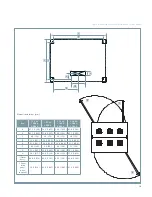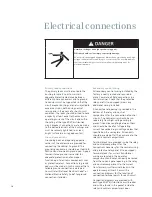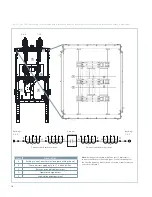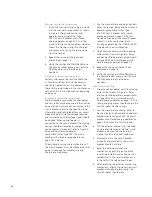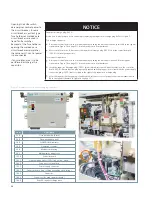
20
Manual spring charging check
1. Insert the manual spring charging crank
into the manual charge socket as shown
in Figure 6: Relay and control and
operator compartments for type
SDV7-SE circuit breaker with stored-
energy operator on page 19. Turn the
crank until the spring condition indicator
shows the closing springs are charged,
and remove the spring charging crank
from the socket.
2. Repeat the spring discharge check
presented on page 18.
3. Verify the springs are DISCHARGED and
the circuit breaker primary contacts are
OPEN by observing the indicator
positions.
As-found and vacuum check tests
Perform and record the results of both the
as-found insulation test and the vacuum
check high-potential test. Procedures for
these tests are described in the maintenance
section of this instruction manual beginning
on page 35.
Automatic spring charging check
Note: A temporary source of control power
and test leads may be required if the control
power source has not been connected to the
circuit breaker. Refer to the specific wiring
information and rating label for your circuit
breaker to determine the voltage required
and where the control voltage signal should
be applied. When control power is
connected to the circuit breaker, the closing
springs should automatically charge if the
control power disconnect (refer to Figure 6:
Relay and control and operator
compartments for type SDV7-SE circuit
breaker with stored-energy operator on
page 19) is closed.
The automatic spring charging features of
the circuit breaker must be checked. Control
power is required for automatic spring
charging to take place.
1. Use the manual close and open controls
(refer to Figure 6: Relay and control and
operator compartments for type
SDV7-SE circuit breaker with stored-
energy operator on page 19) to first
close and then open the circuit breaker
contacts. Verify contact positions
visually by observing the OPEN/CLOSED
indicator on the circuit breaker.
2. Open control power circuit by opening
knife switch shown in Figure 6: Relay
and control and operator compartments
for type SDV7-SE circuit breaker with
stored-energy operator on page 19.
3. Repeat the spring discharge check
presented on page 18.
4. Verify the springs are DISCHARGED and
the circuit breaker primary contacts are
OPEN by observing the indicator
positions.
External manual trip
1. Energize control power circuit by closing
knife switch shown in Figure 6: Relay
and control and operator compartments
for type SDV7-SE circuit breaker with
stored-energy operator on page 19. The
spring charging motor should charge the
circuit breaker closing springs.
2. Use the manual close control (refer to
Figure 6: Relay and control and operator
compartments for type SDV7-SE circuit
breaker with stored-energy operator on
page 19) to close the circuit breaker.
3. Pull the external manual trip (red knob
on side of enclosure) to trip the circuit
breaker, and maintain the external
manual trip in the “pulled” condition.
4. Attempt to close the circuit breaker
manually and electrically. The circuit
breaker should not close.
5. Reset the external manual trip
mechanism by pushing on the black
reset knob inside the relay and control
compartment. The reset mechanism is
to the left of the relay panel hinges.
6. After resetting the external manual trip
mechanism, attempt to close the circuit
breaker manually or electrically. The
circuit breaker should close.
Содержание SDV7
Страница 54: ...54 Table 16 Remarks ...
Страница 55: ...55 Table 16 Remarks continued ...








